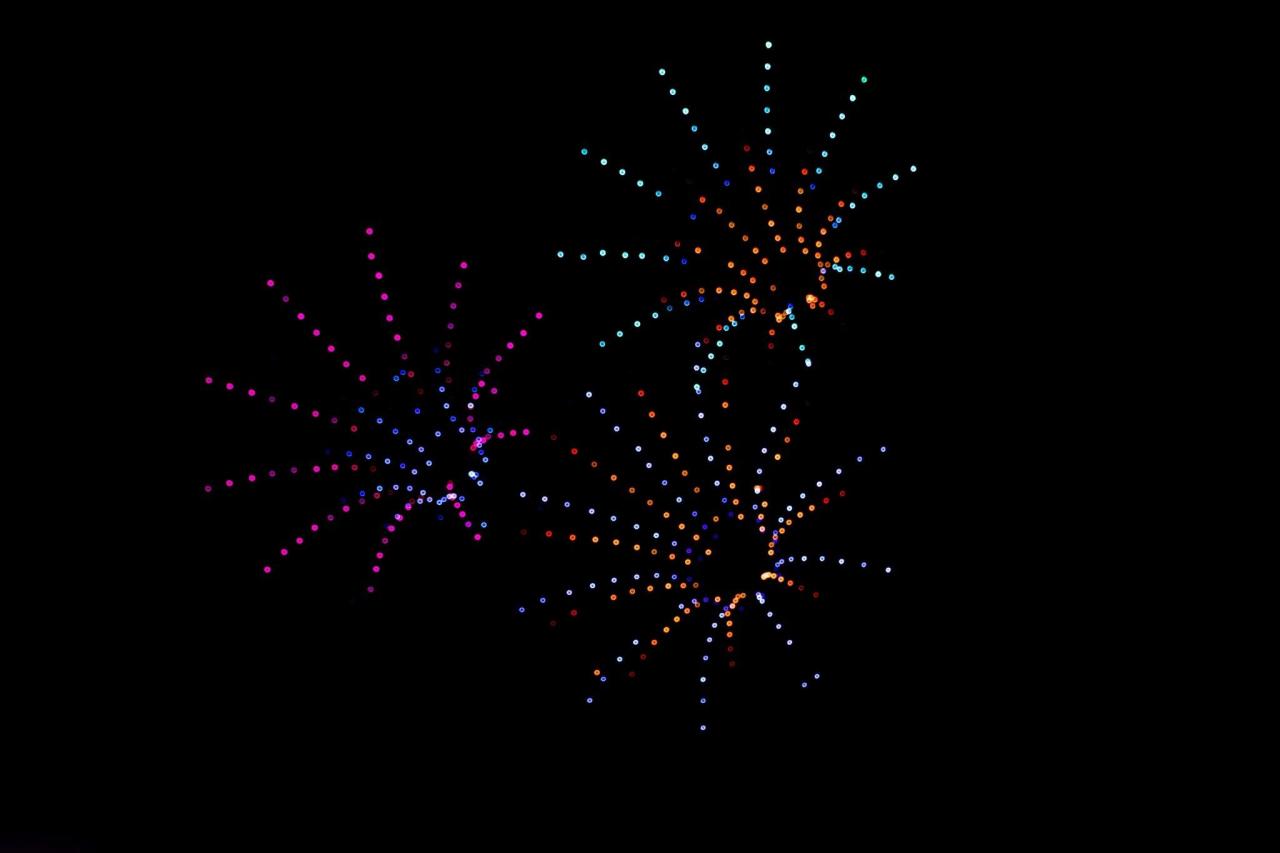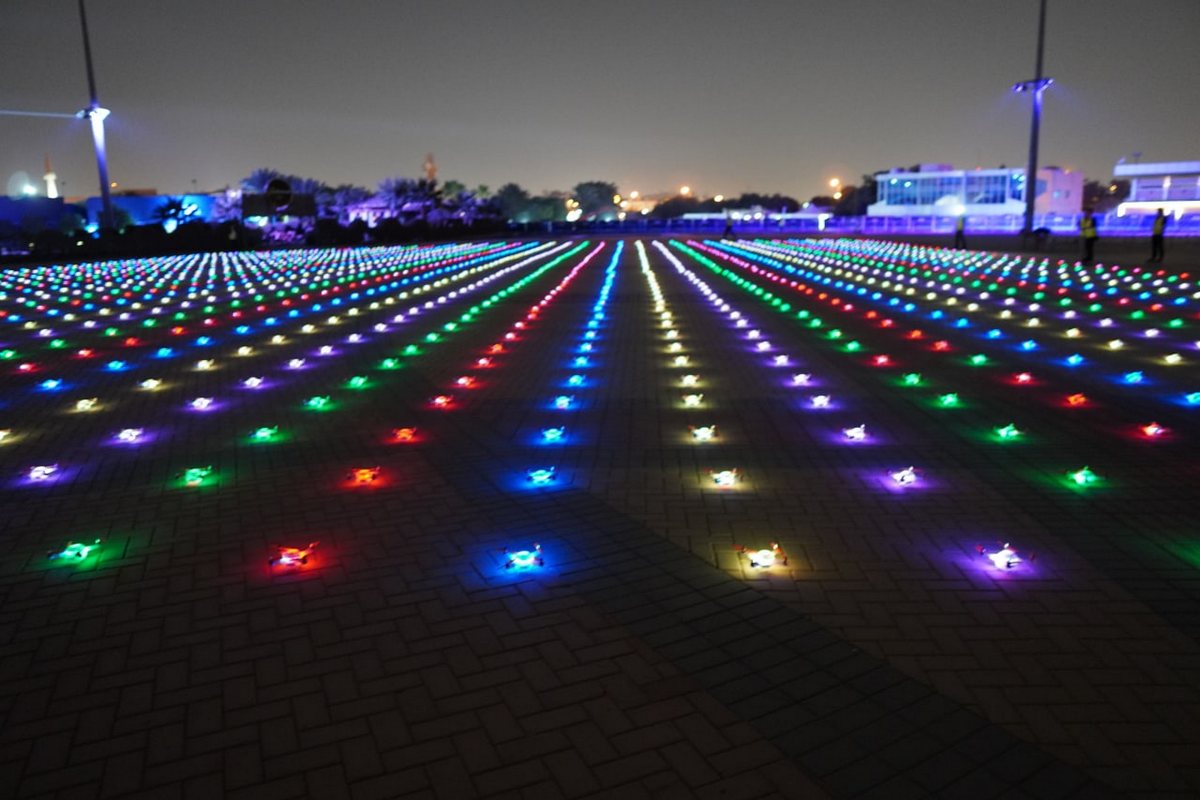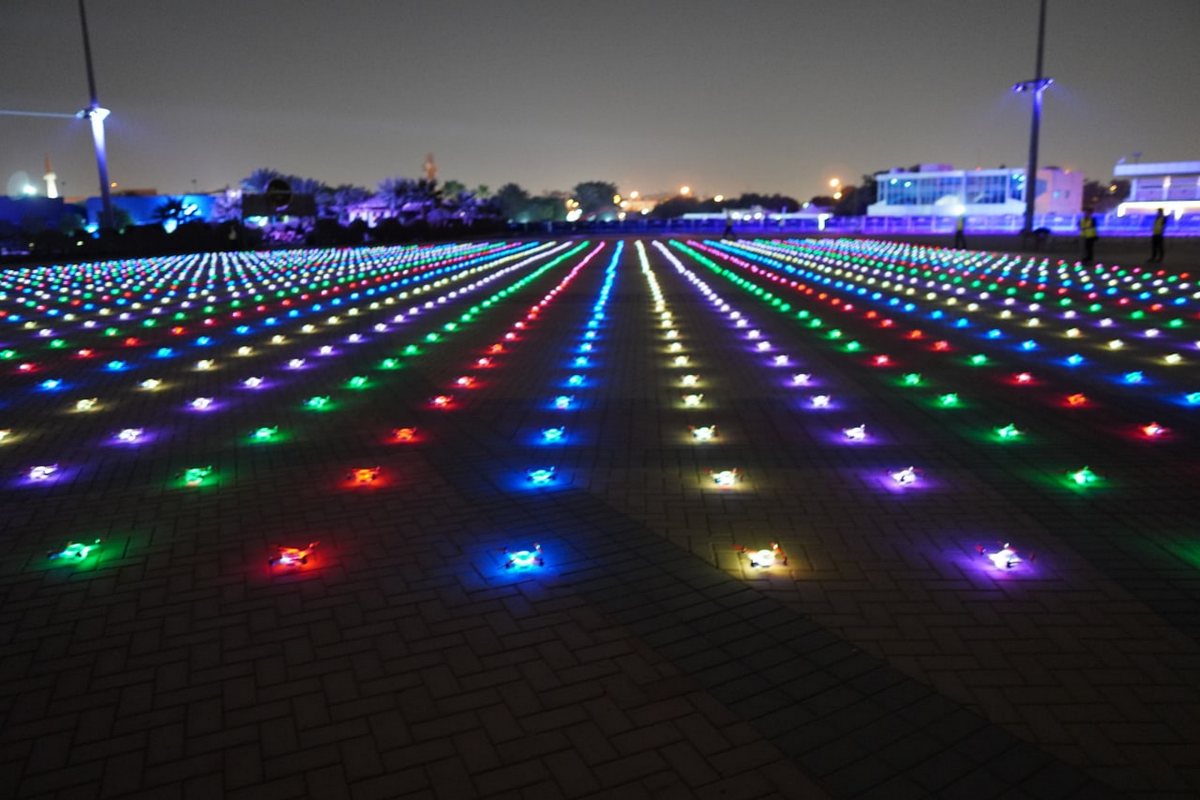How do drone shows work? It’s more than just a bunch of drones flying around! These mesmerizing spectacles are the result of sophisticated technology, precise programming, and meticulous planning. From the specialized drones and communication systems to the intricate choreography and dazzling lighting effects, creating a captivating drone show is a complex undertaking. This guide will take you behind the scenes, revealing the technology and artistry that bring these breathtaking performances to life.
Imagine hundreds, even thousands, of drones moving in perfect synchronization, painting breathtaking images across the night sky. This isn’t magic; it’s the result of careful coordination between hardware, software, and skilled operators. We’ll explore the various components, from the individual drones and their control systems to the software that orchestrates their movements and the planning involved in creating a safe and stunning show.
Drone shows are all about precise choreography and lighting; each drone is a tiny pixel in a massive, flying display. Think of it like a super advanced, aerial version of a game, much like the skill and coordination needed in the traditional Korean game of gonggi game , where players toss and catch small stones with incredible precision.
The result? Breathtaking visuals created by the coordinated movements of hundreds, even thousands, of drones working together in perfect harmony.
Drone Show Technology
Drone shows are a captivating spectacle of coordinated aerial movements and dazzling light displays. This captivating visual experience relies heavily on the technology behind the drones themselves, their control systems, and their positioning systems.
Types of Drones Used in Drone Shows
Drone shows typically utilize small, lightweight quadcopter drones. These are chosen for their maneuverability, ease of control, and ability to carry LED lighting systems. While various manufacturers produce suitable drones, key features include robust flight controllers, precise motor control, and reliable communication systems. Larger, heavier drones are less common due to their reduced agility and increased logistical challenges.
Drone Communication Systems
Simultaneous control of numerous drones demands a robust and reliable communication system. Commonly used are 2.4 GHz and 5.8 GHz radio frequency (RF) systems, providing the necessary bandwidth for real-time control signals and data transmission. These systems often incorporate redundancy and error correction to ensure smooth and consistent operation even with signal interference. Advanced systems may use multiple communication channels for enhanced reliability and to reduce latency.
GPS-Based vs. Vision-Based Positioning

Two primary positioning systems are used in drone shows: GPS-based and vision-based. GPS-based systems rely on satellite signals for positioning, providing relatively accurate location data but susceptible to interference and signal loss. Vision-based systems, on the other hand, use onboard cameras and computer vision algorithms to track the drone’s position relative to markers or other drones. Vision-based systems offer greater precision in close-quarters formations but are less reliable in environments with poor visibility.
Drone Specifications, How do drone shows work
| Drone Model | Weight (g) | Battery Life (min) | Payload Capacity (g) |
|---|---|---|---|
| Example Drone A | 250 | 15 | 50 |
| Example Drone B | 300 | 18 | 60 |
| Example Drone C | 280 | 16 | 55 |
Software and Programming
The intricate choreography and precise movements of a drone show are the result of sophisticated software and programming. This involves specialized software for show design, flight path planning, and real-time control of the drone swarm.
Drone Show Choreography Software
Dedicated software packages allow show designers to create complex flight patterns and lighting sequences visually. These programs typically offer intuitive interfaces with drag-and-drop functionality for easy arrangement of drone movements and timing. They often include features for simulating the show, detecting potential collisions, and exporting flight plans for upload to the drones.
Programming Languages and Algorithms
Drone show programming often involves languages like C++, Python, and specialized scripting languages provided by drone manufacturers. Algorithms are crucial for path planning, collision avoidance, and maintaining formation. Common algorithms include those for path optimization, flocking behavior, and distributed consensus.
Drone shows are amazing, right? Hundreds of drones, all programmed to move in perfect synchronization to create dazzling light patterns. It’s a complex system, needing precise GPS and communication; imagine the chaos if something went wrong, like a major incident affecting air traffic, such as the south korean plane crash , which highlights the importance of airspace management.
Understanding these complexities helps us appreciate the technology behind these spectacular drone displays.
Programming Techniques for Complex Flight Patterns
Creating complex patterns requires advanced programming techniques. These include using Bézier curves to define smooth, curved paths, employing spline interpolation for accurate transitions between waypoints, and implementing algorithms for swarm behavior to create formations like lines, circles, and complex geometric shapes. Multi-threading and parallel processing techniques are often used to manage the control of numerous drones simultaneously.
Drone Show Programming Flowchart
A simplified flowchart would begin with show design and choreography, followed by the translation of the choreography into flight paths and control commands, then the compilation and uploading of the code to the drones. The final step involves pre-flight checks and the execution of the show with real-time monitoring and control.
Flight Planning and Safety
Careful planning and adherence to safety protocols are paramount for successful and risk-free drone shows. This involves considering various environmental factors, potential hazards, and regulatory requirements.
Factors Considered in Flight Path Planning
Flight path planning considers factors such as wind speed and direction, airspace restrictions, potential obstacles (buildings, trees, power lines), and the proximity of spectators. The flight path needs to ensure sufficient clearance and avoid any potential hazards. The show’s duration and the complexity of the formations also influence the planning process.
Safety Hazards and Mitigation Strategies
Potential hazards include drone malfunctions (motor failure, communication loss), collisions, and uncontrolled crashes. Mitigation strategies involve using redundant systems, implementing fail-safe mechanisms, conducting thorough pre-flight checks, and having trained personnel on standby for immediate response to any incidents. Emergency landing procedures should be well-defined and practiced.
Regulations and Guidelines for Safe Drone Shows
Drone shows are subject to various regulations, depending on the location and the scale of the event. These regulations typically cover aspects such as airspace authorization, pilot licensing, insurance requirements, and safety protocols. Adherence to these regulations is crucial for legal compliance and public safety.
So you wanna know how drone shows work? It’s all about precise programming and lots of individual drones working together. Each tiny drone is a pixel in a giant, flying screen, and they move in perfect synchronization to create the images and effects you see. The result? Amazing light shows that wouldn’t be possible without this level of coordinated flight control.
Obtaining Permits and Approvals
Obtaining necessary permits and approvals involves contacting the relevant aviation authorities and local government agencies. This process usually requires submitting a detailed flight plan, demonstrating compliance with safety regulations, and providing proof of insurance and pilot qualifications. The approval process can take several weeks or even months, depending on the complexity of the event and the regulatory requirements.
Lighting and Visual Effects
The visual spectacle of a drone show is greatly enhanced by the lighting systems integrated into the drones. The choice of lighting technology, color control, and brightness significantly impact the overall aesthetic appeal.
Types of Drone Lighting Systems
Common lighting systems include RGB LEDs, which offer a wide range of colors and brightness control. These LEDs are typically small, energy-efficient, and durable enough to withstand the rigors of flight. More advanced systems may incorporate different LED configurations or even incorporate other light sources for unique visual effects.
Creative Lighting Techniques
Creative lighting techniques include using color gradients to create smooth transitions, employing dynamic lighting patterns to emphasize formations, and synchronizing light changes with music or other elements of the show. Light can be used to create illusions of depth, movement, and even three-dimensional shapes in the air.
Color and Brightness Control
Precise control of color and brightness is crucial for creating a cohesive and visually appealing show. This is achieved through software control of the individual LEDs on each drone. The ability to adjust the intensity and hue of each light allows for subtle and dramatic changes in the visual landscape.
Comparison of Lighting Technologies
| Lighting Technology | Brightness (lumens) | Color Range | Power Consumption (W) |
|---|---|---|---|
| RGB LED (Example A) | 10-50 | Full spectrum | 1-3 |
| RGB LED (Example B) | 20-100 | Full spectrum | 2-5 |
Synchronization and Coordination
The success of a drone show hinges on the precise synchronization and coordination of hundreds, or even thousands, of individual drones. Maintaining perfect formation and timing requires sophisticated control systems and algorithms.
Challenges of Synchronizing Multiple Drones
Challenges include maintaining consistent communication between the control system and each drone, compensating for variations in drone performance, and dealing with environmental factors like wind. Slight variations in individual drone behavior can quickly lead to the breakdown of the overall formation and timing.
Methods for Maintaining Formation and Timing
Methods involve using real-time feedback from each drone’s position and orientation sensors, implementing robust control algorithms to compensate for errors, and using distributed consensus protocols to ensure all drones agree on their position and timing. Redundancy in communication and control systems is also essential.
Comparison of Synchronization Techniques
Different techniques exist, ranging from centralized control, where a single system controls all drones, to decentralized control, where drones coordinate their movements locally with each other. Hybrid approaches combining both centralized and decentralized control are also common.
Step-by-Step Guide to Synchronizing Drone Movements
- Precise calibration of each drone’s sensors and communication systems.
- Upload of synchronized flight plans to all drones.
- Real-time monitoring of drone positions and adjustments as needed.
- Implementation of error correction algorithms to compensate for deviations.
- Continuous monitoring and adjustments throughout the performance.
Drone Show Production and Logistics
Producing a drone show is a complex undertaking involving meticulous planning, coordination, and execution. It requires a skilled team, specialized equipment, and careful consideration of logistical challenges.
Steps Involved in Drone Show Production
- Concept development and design.
- Choreography and programming.
- Drone preparation and testing.
- Site survey and risk assessment.
- Permits and approvals.
- Show rehearsal and final execution.
Roles and Responsibilities of Team Members
A typical team includes show designers, programmers, drone pilots, safety officers, logistics managers, and support staff. Each member plays a crucial role in the overall success of the show.
Logistical Challenges
Logistical challenges include transporting a large number of drones and equipment, setting up the control system and infrastructure at the show location, ensuring adequate power supply, and managing on-site personnel.
Drone shows use hundreds of drones programmed to fly in complex formations, creating dazzling light displays. It’s amazing how precise the technology is, especially when you consider the potential for things to go wrong, like what happened with the recent south korean plane crashes , highlighting the importance of reliable navigation systems. Understanding the intricate programming and communication systems involved in drone shows helps appreciate the complexity behind these spectacular events.
Essential Equipment for a Successful Drone Show

- Drones and batteries.
- Control system and software.
- Communication equipment.
- Power generators.
- Safety equipment.
- Transportation vehicles.
The Future of Drone Shows
The field of drone shows is constantly evolving, driven by advancements in technology and creative innovation. The future holds exciting possibilities for increased autonomy, enhanced visual effects, and more immersive experiences.
Emerging Technologies
Emerging technologies like artificial intelligence (AI) for autonomous choreography, improved battery technology for longer flight times, and miniaturized lighting systems for more intricate designs are poised to significantly impact the future of drone shows.
Increased Autonomy and AI
AI could automate aspects of show design, flight planning, and even real-time control, enabling the creation of more complex and dynamic shows with less human intervention. AI-powered collision avoidance systems will enhance safety.
Future Trends and Innovations

We can expect to see more sophisticated lighting effects, the integration of other technologies like augmented reality (AR) and virtual reality (VR), and potentially even the use of drones in conjunction with other performance elements, such as pyrotechnics or water displays.
Evolution of Drone Shows
Drone shows might evolve from simple geometric formations to intricate, story-driven narratives projected in the sky. The integration of AR could overlay digital content onto the real-world drone display, creating a more immersive and interactive experience for the audience. Imagine drone shows that react in real-time to audience participation or environmental conditions.
Ending Remarks: How Do Drone Shows Work
Drone shows are a testament to the power of technology and creative collaboration. By understanding the intricate interplay of hardware, software, and meticulous planning, we can appreciate the artistry and engineering that go into these captivating displays. From the initial concept to the final breathtaking performance, each element plays a crucial role in delivering an unforgettable experience. As technology continues to advance, the possibilities for even more spectacular and complex drone shows are limitless, promising even more awe-inspiring visual experiences in the future.
Top FAQs
How long does it take to plan a drone show?
Planning a drone show can take anywhere from a few weeks to several months, depending on the complexity and scale of the performance.
What happens if a drone malfunctions during a show?
Most drone show systems have redundancy built-in. If one drone malfunctions, the show can often continue without significant interruption. Safety protocols are also in place to ensure the safe landing of malfunctioning drones.
How much does a drone show cost?
The cost of a drone show varies greatly depending on factors like the number of drones, show duration, complexity of the choreography, and location.
Are drone shows environmentally friendly?
Modern drones are becoming increasingly efficient, and show organizers are often mindful of environmental impact, choosing quieter drones and minimizing energy consumption.
